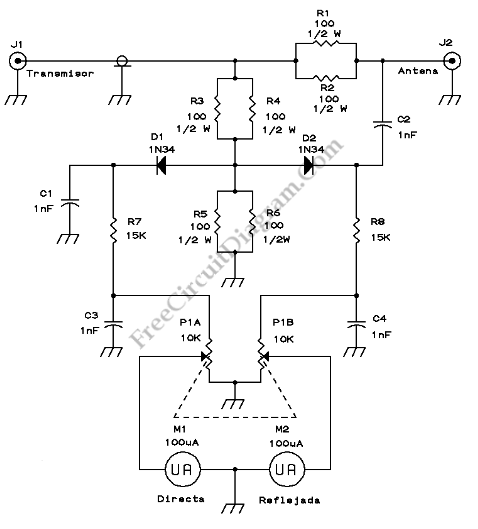Simple Wideband SWR Meter

This is a circuit of Wideband SWR Meter. This circuit is used as a test instrument. To use this circuit, connect the meter, take the necessary readings, then disconnect. The meter should not be left in the line permanently because it draws up 3/4 of the transmitted power, and a similar part of a received signal. This circuit uses Three pairs of 100 Ohm resistors those are combined in a bridge circuit, with the load as the fourth resistor. The diode, D1, is used to rectify a sample of the input signal, while D2 used to rectify the differential voltage across the bridge. So, the square root of reflected power can be achieved. Here is the circuit:
The two output voltages of the circuit are applied to two simple galvanometers and to a ganged potentiometer. Besides that, this output voltage can be applied to digital displays, microprocessors, etc.
A 5Vrms RF signal is applied to the input and A 50 Ohm load is connected to the antenna side. So 1/2W will across 50 Ohm. D1 provides 3.5V DC because At the anode of D1 have 2.5Vrms, or 3.5V peak. D2 will not produce any DC output because it see exactly the same RF voltage at both sides, and in the same phases. The meter indicate a 1:1 SWR when The forward meter move, while the reflected signal meter will stay at zero. The transmitter will indicate 1:1 SWR too because it see 2 times 100 Ohm in parallel, or 50 Ohm. while the remaining quarter gets delivered to the antenna, One quarter of the power will be dissipated in each of the resistor pairs.
When the extreme condition occurs like the load was disconnected, so the circuit has infinite SWR. D1 see half of the input voltage, and no voltage drop across them, and there is now no current in R1/R2. D2 produces the same rectified output as D1 does because it see “the other half” of the input voltage. So the meter indicate all power is being reflected because both meters deflect by the same amount, and the SWR is infinite. The transmitter indicate a 2:1 SWR because it see 100 Ohm load, far away from causing danger to any transmitter. [Source: Homo Ludens Electronicus]